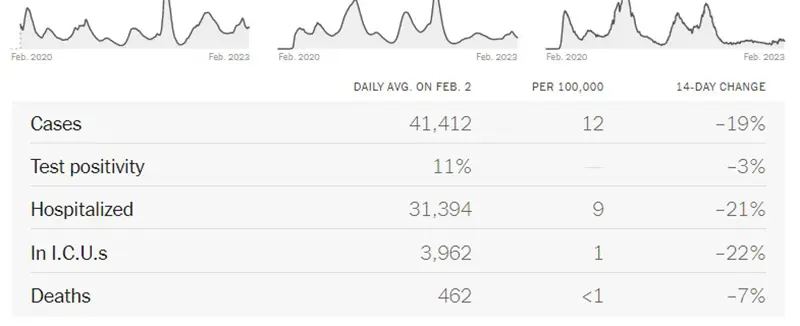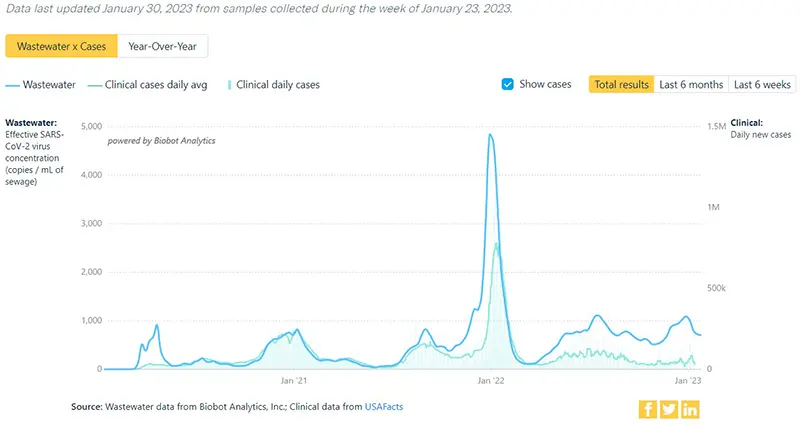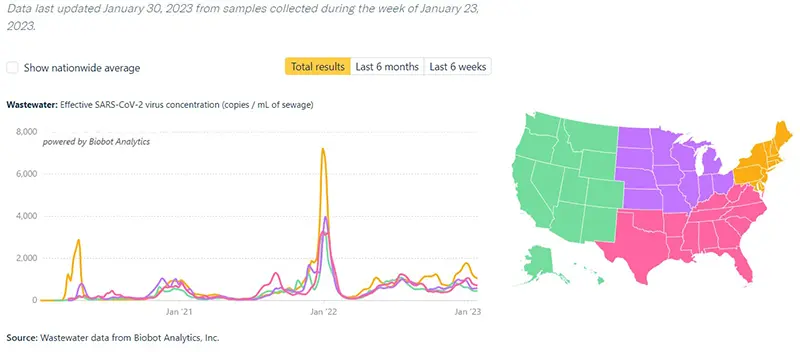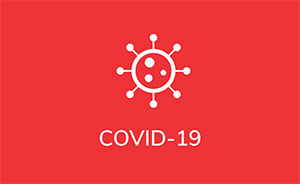Immunocompromised and worried about COVID-19? If you recently had your COVID-19 vaccine booster, you may be eligible for free antibody testing to understand your antibody levels, as part of a research registry for potential participation in a COVID-19 prevention study of investigational monoclonal antibody therapies. Click here to learn more.
In light of the recent news for the immunocompromised community regarding the FDA decision to discontinue the Emergency Use Authorization for Evusheld, CLL Society would like to again remind everyone that the CDC is urging all of those who are immunocompromised (this includes everyone diagnosed with CLL / SLL, regardless of their treatment status) to take extra precautions to avoid COVID-19 infection and severe disease at this time.
Weekly COVID-19 Statistics
Thank you to those of you in our community who have expressed your gratitude for these Weekly COVID-19 Updates throughout the winter months. As we appear to be on the downward slope of the winter surge for all data points, CLL Society plans to slow these COVID-19 Updates down to every other week for now.
This means our next COVID-19 Update will be published the week of February 20th.
Please remember if you have any specific COVID-19 questions, you are always welcome to utilize our Ask the Experts program by sending an email to [email protected].
Here is this week’s CDC map of community level of spread (this particular link is weighted based on hospitalizations and not the actual level of spread). And here is the link to the New York Times actual cases per capita map as pictured below. The New York Times data was last updated February 3rd.

Here is the summary graphic from the New York Times as of February 3rd. We continue to see a downward trend in all 14-day change metrics.

Here is a graphic from the Wastewater Monitoring Project last updated on January 30th. This graphic does not reflect necessarily a decrease in the amount of SARS-CoV-2 virus being detected in wastewater, but instead, more of a plateau.

The additional graphic below from the Wastewater Project shows SARS-CoV-2 viral concentrations by region. All regions are also beginning to reflect a plateau rather than a downward trend, with the highest concentration of SARS-CoV-2 virus amounts detected in the Northeast region of the country.

Hospitalizations due to COVID-19, last updated February 2nd, continue to reflect a decrease as well (gray dotted line graphic on the left). It is very encouraging to see hospitalizations decrease in all age groups, especially for those over the age of 70 who have been disproportionately hospitalized at a much higher rate since the winter wave began (purple solid line on the right).

The weekly average number of COVID-19 deaths according to the CDC in the US ending the week of February 1st was 3,452, which is a decrease of 304 deaths on average from the week prior. We hope to continue seeing this downward trend in average weekly deaths, as this number is still not to the baseline seen before the holiday season.

Current & Emerging Variants of Concern (VOC)
Of interest is a new variant that popped up this week on the CDC’s Variant Tracker as of February 4th called CH.1.1. We do not know much about this variant yet, but if the CDC has decided to begin tracking it, we should keep an eye on it to see if it begins showing any growth advantages over the other dominant variants. As has been the case for many weeks now, the highly transmissible XBB.1.5 variant (also called the Kraken variant) continues to show the most growth advantage over all other variants circulating within the US.
COVID-19 in the News
- One of the biggest stories this past week was the Biden administration’s announcement that the COVID-19 Public Health Emergency declaration will end in May. CLL Society has concerns about this news, and our healthcare policy and advocacy team are monitoring the situation closely. The declaration does not mean the pandemic is over. It simply means that many of the government-funded programs to help Americans navigate and manage their COVID-19 related healthcare needs will no longer be available. Changes that will occur at the end of the declaration in May will include:
- No further COVID-19 vaccinations provided for free through the government and patient copays for additional doses will be determined by individual insurance companies.
- KN95 or N95 masks will no longer be distributed for free through local pharmacies.
- At-home COVID-19 testing kits provided for free by the government through COVIDtests.gov will no longer occur.
- PCR or antigen tests provided through local pharmacies will no longer be free, and it will now be up to insurance companies to determine to what degree these tests are covered (if at all) or if they are reimbursable.
- Continuous enrollment in Medicaid provisions that were provided as part of the declaration will end with this as well, which means it will be up to each state to decide if they are going to immediately disenroll people as part of the continuous enrollment provision that existed under the Public Health Emergency declaration. Only 28 states have plans to prioritize renewal for those who are eligible, and 41 states have said it may take up to 12 months if they do decide to provide renewals in enrollment.
- Oral antivirals will continue to be covered due to the changes made in the Consolidated Appropriations Act (CAA). The Emergency Use Authorization (EUA) process we have seen put in place by the FDA to authorize COVID-19 therapeutics and vaccines will still be in place for now and is a separate declaration from the Public Health Emergency.
- Possible cuts to telehealth visits being covered by insurance companies will occur, except for those who are on Medicare, for which the telehealth flexibilities were extended through the end of 2024 through another piece of legislation.
In Summary
If you missed CLL Society’s most recent COVID-19 webinar, you can watch it on demand here.
Please know that CLL Society has remained diligent in working behind the scenes in terms of the ongoing policy and advocacy work that must continue on behalf of our immunocompromised community. As soon as the news on Evusheld was announced, we sent a joint letter that was signed by eight other patient advocacy organizations to key government officials. You can read more about the letter-writing effort here. We will continue to keep an extremely close eye on the potential consequences of the Public Health Emergency ending in May and continue to advocate for the voices of those in our community to be heard.
Keep learning, and please stay well.
Robyn Brumble, MSN, RN
Director of Scientific Affairs & Research
CLL Society

















